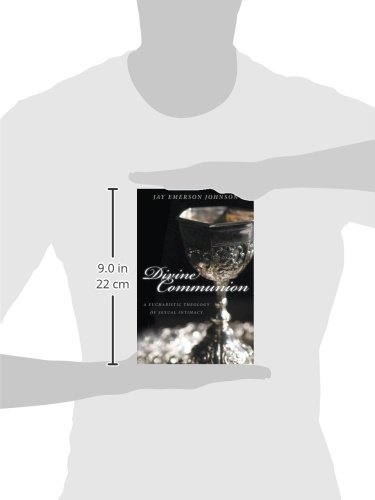All Categories




Divine Communion: A Eucharistic Theology of Sexual Intimacy
Share Tweet
Get it between 2024-05-14 to 2024-05-21. Additional 3 business days for provincial shipping.
*Price and Stocks may change without prior notice
*Packaging of actual item may differ from photo shown
- Electrical items MAY be 110 volts.
- 7 Day Return Policy
- All products are genuine and original
- Cash On Delivery/Cash Upon Pickup Available








About Divine Communion: A Eucharistic Theology Of Sexual
Excerpt. © Reprinted by permission. All rights reserved. Divine Communion A EUCHARISTIC THEOLOGY OF SEXUAL INTIMACY By Jay Emerson Johnson Church Publishing IncorporatedCopyright © 2013 Jay Emerson Johnson All rights reserved. ISBN: 978-1-59627-252-1 Contents PrefaceIntroduction: The One Story1. Creation: Sensuous Desire and Bodily Shame2. Fall: Carnal Wisdom and Spiritual Folly3. Salvation: Bodily Glory and Religious Violence4. Eucharist: Earthly Food and Heavenly SexConclusion: Covenants for the Beloved CommunityAppendix: Reading Biblical Sexuality for Mission and Ministry CHAPTER 1 Creation Sensuous Desire and Bodily Shame In your infinite loveyou made us for yourself ... —"Eucharistic Prayer A"The Book of Common Prayer Food, sex, and, religion—these make human history possible to tell and to write,and not only because the human species would disappear without nourishing foodand procreative sex. Human history has always dealt with more than merelysurviving; human beings insist on making meaning from our existence. Religion inall its multivalent forms has been the primary way for humanity to hew meaningfrom both the triumphant glories and hard-scrabble conditions of human life. Afailed crop, a successful pregnancy, abundant harvests, declining rates ofchildbirth—each of these has populated the explanatory and intercessorymechanisms of religion in various ways for millennia. Some of the earliest religious rites in human history orbited around fertilityand its twin expressions—the procreation of children and fruitful crops. Whyreligions have so often turned to progeny and food, or sexual intimacy andbodily sustenance, seems nearly self-evident when the conditions for thesurvival of a community hang in the balance. Food, sex, and religion all belongtogether naturally and even organically in societies with no guarantee offlourishing for their offspring. Those societies may or may not developreligious traditions that involve a Creator God, but they will undoubtedlygenerate rites that highlight the sensuality of human existence—tilling soil,planting seeds, eating food, bodily desire, sexual intimacy, giving birth, and,of course, dying. The Book of Common Prayer retains traces of these ancient cycles of humanity'ssymbiotic relationship with Earth, with the wideness and depth of God'screation. Those roots stretch back to a European agrarian past and even fartherback to ritual celebrations of agricultural fertility and sexual fecundity.Rural faith communities may appreciate that history more readily than today'surban or even suburban churches. Litanies and rites for "rogation days," forexample, began in fifth-century France following a series of natural disasters,and evolved into liturgical occasions devoted to asking God for a healthyharvest from both land and sea ("rogation" comes from the Latin rogare, "toask"). The 1979 Prayer Book expanded this "asking" to include those engaged in"commerce and industry" and more broadly still for all to renew our commitmentto a proper "stewardship of creation." These relatively minor liturgical tracesof humanity's reliance on earth, rain, and crops will certainly take on newfoundsignificance in an era of global climate change. Addressing effectively ourgrowing ecological crises will demand more from us, however, than expanding thescope of rogation day prayers. Healing the breach between humans and ourplanetary home can begin by bringing the sensuous and bodily rhythms of sexualintimacy with us to the Eucharistic Table, where we offer tokens of Earth'sbounty—bread and wine. Christian communities have always worshipped the Creator God, yet modern Westernculture has made the earthy and bodily roots of religious rites seem ratherquaint, if not irrelevant. A host of factors contributed to this liturgicalambivalence toward the sensual rhythms of planetary life, including greaterefficiencies in food production, the European Enlightenment (with its stress onrationality at the expense of embodi

















